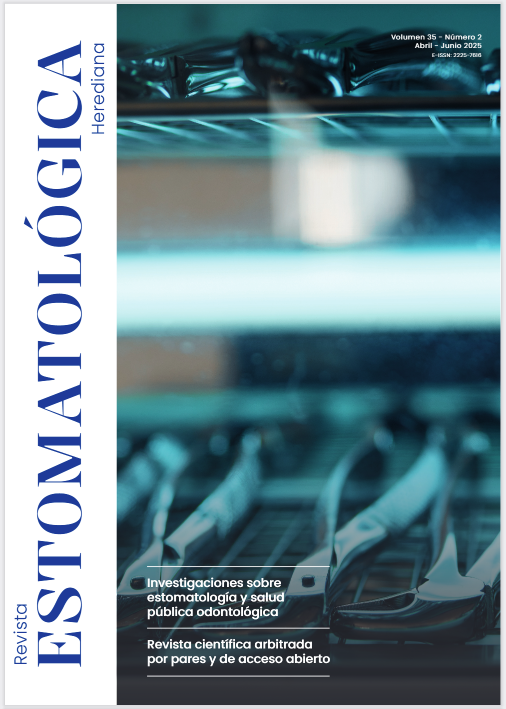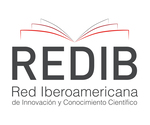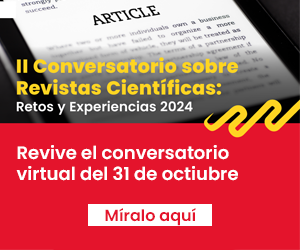Microleakage in lithium disilicate veneers cemented with resin cement and thermally modified resin
DOI:
https://doi.org/10.20453/reh.v35i2.5456Keywords:
resin cements, dental cements, microleakage, dental porcelainAbstract
Objective: To determine in vitro microleakage in lithium disilicate veneers cemented with resin cement and thermally modified resin. Materials and methods: An in vitro study was conducted using 20 maxillary premolars, on which lithium disilicate veneers were cemented. The specimens were divided into two groups of ten samples each. Each tooth was prepared on the vestibular surface for subsequent veneer fabrication. In Group 1, veneers were cemented with resin cement (Nexus-3), whereas in Group 2, thermally modified resin (Herculite Précis™) was used. Subsequently, the teeth underwent a thermocycling process and were immersed in a 2% methylene blue solution for five days, after which sagittal sections were performed for observation under an optical microscope. Results: A higher percentage of microleakage was observed in the group cemented with resin cement (47.5%; n = 19) compared to the group treated with thermally modified resin (32.5%; n = 13), with a p-value of = 0.018. Additionally, greater microleakage was detected at the cervical and mid-levels in the resin cement group compared to the thermally modified resin group, with a p-value of = 0.046. Conclusion: Microleakage was observed in both groups. When comparing the two luting agents, resin cement showed significantly greater microleakage than thermally modified resin.
Downloads
References
Kidd EA. Microleakage: a review. J Dent [Internet]. 1976; 4(5): 199-206. Disponible en: https://doi.org/10.1016/0300-5712(76)90048-8
Mezzomo E. Rehabilitación oral para el clínico. Caracas: Actualidades Médico Odontológicas Latinoamericana; 1997.
Abdulrahman MS. Evaluation of the sealing ability of direct versus direct-indirect veneer techniques: an in vitro study. Biomed Res Int [Internet]. 2021; 2021: 1118728. Disponible en: https://doi.org/10.1155/2021/1118728
Macchi RL. Materiales dentales. Buenos Aires: Médica Panamericana; 2007.
Durán G. Cementación de carillas cerámicas de disilicato de litio utilizando RelyX® Veneer. Reporte de un caso. Infodent Plus. 2019; (91): 10-12.
Henostroza G. Adhesión en odontología restauradora. São Paulo: Maio; 2003.
Patussi AF, Ramacciato JC, Silva JG, Nascimento VR, Campos DE, Munizz IA, et al. Preheating of dental composite resins: a scoping review. J Esthet Restor Dent [Internet]. 2023; 35(4): 646-656. Disponible en: https://doi.org/10.1111/jerd.12991
Crespo Requeni MJ, Faus Llácer VJ, Fethke Girardi K, Regolf Barceló JJ. Adhesión porcelana-dentina: microfiltración en facetas de porcelana. EJDR [Internet]. 1998; (3): 11. Disponible en: https://www.uv.es/pascuala/ejdr/Art00011.htm
Barbosa A, Espinosa C, Ortiz Y, Cuellar MA, Parra DY. Microfiltración en incrustaciones inlay en disilicato de litio técnicainyectada con dos tipos de cementos resinosos. J Odont Col [Internet]. 2016; 9(17): 8-16. Disponible en: https://revistas.unicoc.edu.co/index.php/joc/article/view/331
Buchelli MC. Evaluación de la microfiltración en restauraciones indirectas cementadas con resina precalentada, cemento de grabado total y un agente autoadhesivo [tesis de postgrado en Internet]. Quito: Universidad San Francisco de Quito; 2017. Disponible en: http://repositorio.usfq.edu.ec/handle/23000/6432
Jain S, Gupta A, Jain D. Estimation of sample size in dental research. Int Dent Med J Adv Res. 2015; 1: 1-6.
Magne P, Alawie S, Magne M, Carvalho M, Milani T. Comparison of film thickness of restorative composites considered for thermo-modified cementation. J Esthet Restor Dent [Internet]. 2024; 37(1): 28-38. Disponible en: https://doi.org/10.1111/jerd.13363
Albaheli BI, Elawsya ME, Ali AI. Microleakage of lithium disilicate veneers bonded to different substrates with light-cure and dual-cure resin cements. J Clin Exp Dent [Internet]. 2024; 16(4): e431-e439. Disponible en: https://doi.org/10.4317/jced.61279
Goulart M, Borges Veleda B, Damin D, Bovi Ambrosano GM, Coelho de Souza FH, Erhardt MC. Preheated composite resin used as a luting agent for indirect restorations: effects on bond strength and resin-dentin interfaces. Int J Esthet Dent [Internet]. 2018; 13(1): 86-97. Disponible en: https://pubmed.ncbi.nlm.nih.gov/29379905/
Downloads
Published
How to Cite
Issue
Section
License
Copyright (c) 2025 GUSTAVO BECERRA INFANTAS, Midori PORRAS MENDOZA

This work is licensed under a Creative Commons Attribution 4.0 International License.
The authors retain the copyright and cede to the journal the right of first publication, with the work registered with the Creative Commons License, which allows third parties to use what is published as long as they mention the authorship of the work, and to the first publication in this journal.























